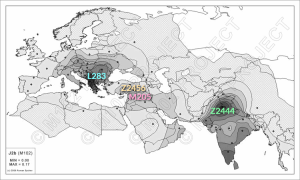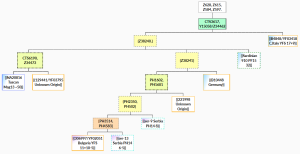The early Neolithic split of J2b2a-M241 (YFull 9700 ybp) in to the modern western (L283, Balkans) and eastern (Z2444, India) subclades is detected since at least a decade trough testing of the M241 SNP in scientific studies. According to the current YFull L283 samples the lineages expanded sometime earlier then 5200 ybp, while the Asian lineages expanded since 7100 ybp. This gives ca. 4000 years to the L283 lineages to move away from the split from Z2444, most likely to the Balkans area. The earliest European J2-M172 is found in Neolithic Sopot Culture in Hungary (sample ALE14, ca. 7000 ybp ). Further testing most likely will show this men positive for L283 and then give proof of presence for 7 millennia in Southeast Europe.
In J2@FTDNA project currently 245 kits with at least Y-STR37 testing are members of L283 groups. Of those samples all with MDKO (most distant known ancestor) not in the New World all are from Europe except the listed kits :
- L283>Z590>Z584,Z597>?
221083 Saqqar Aleppo, Saudi Arabia J-M172 (predicted, this sample may also be Z2444) - L283>Z590>Z584>Z638>Z1296>?
N32432 AbiEzzi, Lebanon J-M172 (predicted)
191409 Bassil, Fidar, Lebanon J-L283
99517 Aboud, Lebanon J-M102 - L283>Z590>Z584>Z638>Z1296>Z1297>Z631>Z1048,Z1043?
294429 Tabet C. 1700 Deir El Qamar, Lebanon J-M172 - L283>Z590>Z584>Z638>Z1296>Z1297>Z631>Z1048>?
247269 Morocco J-M172 (predicted)
The known NextGenSequences (NGS, see J2-M172 Research Tree simplified) for L283 are currently 52. Of them those are not European:
- L283>CTS3681
RISE408 ancient Armenia ~1109 BC - L283>Z590>Z584>Z638>Z1296>PH1751>Z38300
306877 Circassia, Abazin (might count as European but listed nonetheless) - L283>Z590>Z584>Z638>Z1296>Z1297>Z631>Z1048>Z8425>Z8429
EB-16138 Cochin-Jewish India
Even without comparing in detail to the other J2b or J2a haplogroups the lack of presence in Middle East is obvious and no early split diversity in or near the Fertile Crescent seems to exist, except for the ancient Armenian sample. But this presence like all the other listed samples could be an expansion from Balkans/Greece to the East.
Jewish subgroups
An interesting case to study in L283 are the known Jewish subgroups:
- L283>Z590>Z584>Z638>Z1296>Z1297>Z631>Z1048>Z8425>Z8429
EB-16138 Cochin-Jewish India
- L283>Z590>Z584>Z638>Z1296>Z1297>Z631>Z1048>Z8425>Z8429>?
8 kits in J2@FTDNA with Y37+, Z1043,Z1048 confirmed positive, from Colombia, Poland, Ukraine, Lithuania. This cluster was discovered only recently. - L283>CTS3681>Z628>Z638>CTS3617? DYS455=8
19 kits in J2@FTDNA with Y37+, Z638(xZ1296,YP129) confirmed, all kits from Eastern Europe except one from France. A candidate member has matching Geno2-SNP only results with Iberian origins.
Hammer et al 2009 list 44 of 952 Jewish Y-chromosomes as positive for J2b-M12 (4.6%) of which 16 are assigned to Cohanim lineages out of a total of 215 (7.4%).
The age of Z8429 diversification is estimated by YFull to 2900 ybp and members of this haplogroup are from Western Europe, Northern Europe, Tatar Russia as well the Jewish groups from Europe and India. The Tatar as well the Indian presence is interesting and rises the question to which culture this haplogroup belonged.
The CTS3617? DYS455=8 group is since long researched by Sidney Sachs and has Cohanim tradition. CTS3617 is estimated by YFull with 3700 ybp and only very recently SNP results suggest this position under L283. So far the placement under CTS3617 is not known. The confirmed CTS3617 samples are diverse and from Balkans, Italy and Germany (see J2b-CTS3617: southern brother of Z638 detected in Balkans and Italy). Wim Penninx in his analysis of the known Y-DNA ancestors of Ashkenazi Jews
estimates the TMRCA of the Jewish DYS455=8 group to 369-906 CE and currently lists no most likely origin. As a possible nearest outgroup match 324786 Bosnia-Herzegovina has a GD of ca. 20/67 and is grouped himself into CTS3617>Z38240>Z38241>PH1602>PH2350>PH3514, a group with NGS results from Bulgaria and Serbia.
The DYS455=8 value is very unique in J2@FTDNA: no other members share this value. Two confirmed M172 of the same surname lineage from Switzerland, kit 26402 (Y-STR37) and kit 155275 (Y-STR67) have DYS454=8 instead and likewise unique in J2 for which a possible mutation connection is proposed by Sidney Sachs. Using Infinite allele mutation model kit 155275 and a Y-STR111 match (kit B5308) with also DYS454=8 have a GD of 16-21/67 and 28/111 which using Heinila 2012 mutation rates and 75% TMRCA probability results in a distance of 65-82 (Y67) and 64 (Y111) generations which according to an unpublished comparison of me with YFull TMRCA is beyond a reliable distance based only on Y-STR markers. The “DYS454=8” haplotype in J2@FTDNA matches to diverse clusters before they match the DYS455=8 group. Kit 26402 has tested L283+ and Z1043- so only further SNP testing will solve the relation of the two clusters; currently most informative would be a YFull NGS analysis with TMRCA SNP estimate from both DYS454/455=8 groups.
There are other two Jewish groups in J2b at J2@FTDNA under Z1827,Z575>Z2456 with 14 Y-STR37+ members from Spain, United Kingdom and East Europe and under M205>PH4306>PH1089 with 4 Indian members so far (3 Y-STR37+, one study sample having Mumbai as origin). In the FTDNA database the Indian frequency is underrepresented nonetheless the 19/45 Jewish J2b members match very well the 16/44 Cohanim/Jewish proportion of the Hammer et al 2009 study.
A verification against of the proportion of J2-M172 Jewish samples in the study (22.8%) against those in J2@FTDNA was not done here.
To reconstruct the time and place where the Jewish groups adopted their religion and did migrate to the modern ancestral origins more comprehensive data from them and the nearest out-groups is needed. A connection to the Greek and Phoenician cultures seems possible and one way to explain a migration to and presence for a while in the Levant. If this is also the most likely explanation for the Lebanese L283 samples was not investigated further here. It seems however difficult to exclude an adoption of the Jewish religion in (Southeastern) Europe without a modern presence in Middle East from the nearest out-group.



